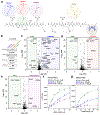In situ chromatin interactomics using a chemical bait and trap approach
- PMID: 32472103
- PMCID: PMC7331920
- DOI: 10.1038/s41557-020-0474-8
In situ chromatin interactomics using a chemical bait and trap approach
Abstract
Elucidating the physiological binding partners of histone post-translational modifications (hPTMs) is key to understanding fundamental epigenetic regulatory pathways. Determining such interactomes will enable the study of how perturbations of these interactions affect disease. Here we use a synthetic biology approach to set a series of hPTM-controlled photo-affinity traps in native chromatin. Using quantitative proteomics, the local interactomes of these chemically customized chromatin landscapes are determined. We show that the approach captures transiently interacting factors such as methyltransferases and demethylases, as well as previously reported and novel hPTM reader proteins. We also apply this in situ proteomics approach to a recently disclosed cancer-associated histone mutation, H3K4M, revealing a number of perturbed interactions with the mutated tail. Collectively our studies demonstrate that modifying and interrogating native chromatin with chemical precision is a powerful tool for exploring epigenetic regulation and dysregulation at the molecular level.
Conflict of interest statement
Competing Interests Statement
The authors declare no competing interests.
Figures




Comment in
-
Exploring epigenetics with chemical tools.Nat Chem. 2020 Jun;12(6):506-508. doi: 10.1038/s41557-020-0471-y. Nat Chem. 2020. PMID: 32472102 No abstract available.
Similar articles
-
Bath: a Bayesian approach to analyze epigenetic transitions reveals a dual role of H3K27me3 in chondrogenesis.Epigenetics Chromatin. 2025 Jun 27;18(1):38. doi: 10.1186/s13072-025-00594-6. Epigenetics Chromatin. 2025. PMID: 40571950 Free PMC article.
-
Crossing epigenetic frontiers: the intersection of novel histone modifications and diseases.Signal Transduct Target Ther. 2024 Sep 16;9(1):232. doi: 10.1038/s41392-024-01918-w. Signal Transduct Target Ther. 2024. PMID: 39278916 Free PMC article. Review.
-
A narrative review of epigenetic marker in H3K27ac and its emerging potential as a therapeutic target in cancer.Epigenomics. 2025 Mar;17(4):263-279. doi: 10.1080/17501911.2025.2460900. Epub 2025 Feb 21. Epigenomics. 2025. PMID: 39981972 Review.
-
[Epigenetics' implication in autism spectrum disorders: A review].Encephale. 2017 Aug;43(4):374-381. doi: 10.1016/j.encep.2016.07.007. Epub 2016 Sep 28. Encephale. 2017. PMID: 27692350 French.
-
Chemical Strategies to Modulate and Manipulate RNA Epigenetic Modifications.Acc Chem Res. 2025 Jun 3;58(11):1727-1741. doi: 10.1021/acs.accounts.4c00844. Epub 2025 Mar 18. Acc Chem Res. 2025. PMID: 40100209 Review.
Cited by
-
Spatiotemporal and direct capturing global substrates of lysine-modifying enzymes in living cells.Nat Commun. 2024 Feb 17;15(1):1465. doi: 10.1038/s41467-024-45765-3. Nat Commun. 2024. PMID: 38368419 Free PMC article.
-
Mina53 demethylates histone H4 arginine 3 asymmetric dimethylation to regulate neural stem/progenitor cell identity.Nat Commun. 2024 Nov 26;15(1):10227. doi: 10.1038/s41467-024-54680-6. Nat Commun. 2024. PMID: 39587091 Free PMC article.
-
Development of Complementary Photo-arginine/lysine to Promote Discovery of Arg/Lys hPTMs Interactomes.Adv Sci (Weinh). 2024 Apr;11(14):e2307526. doi: 10.1002/advs.202307526. Epub 2024 Jan 31. Adv Sci (Weinh). 2024. PMID: 38298064 Free PMC article.
-
Chemical Biology Approaches to Identify and Profile Interactors of Chromatin Modifications.ACS Chem Biol. 2023 Apr 21;18(4):1014-1026. doi: 10.1021/acschembio.1c00794. Epub 2022 Mar 3. ACS Chem Biol. 2023. PMID: 35238546 Free PMC article. Review.
-
Chemical biology approaches to study histone interactors.Biochem Soc Trans. 2021 Nov 1;49(5):2431-2441. doi: 10.1042/BST20210772. Biochem Soc Trans. 2021. PMID: 34709376 Free PMC article. Review.
References
-
- Aebersold R & Mann M Mass-spectrometric exploration of proteome structure and function. Nature 537, 347–355 (2016). - PubMed
-
- Li B, Carey M & Workman JL The Role of Chromatin during Transcription. Cell 128, 707–719 (2007). - PubMed
-
- Kouzarides T Chromatin Modifications and Their Function. Cell 128, 693–705 (2007). - PubMed
-
- Dawson MA & Kouzarides T Cancer epigenetics: From mechanism to therapy. Cell 150, 12–27 (2012). - PubMed
References (Methods section only)
-
- Cox J & Mann M MaxQuant enables high peptide identification rates, individualized p.p.b.-range mass accuracies and proteome-wide protein quantification. Nat. Biotechnol 26, 1367–1372 (2008). - PubMed
-
- Benjamini Y & Hochberg Y Controlling the False Discovery Rate: A Practical and Powerful Approach to Multiple Testing. J. R. Stat. Soc. Ser. B 57, 289–300 (1995).
Publication types
MeSH terms
Substances
Grants and funding
LinkOut - more resources
Full Text Sources
Molecular Biology Databases

